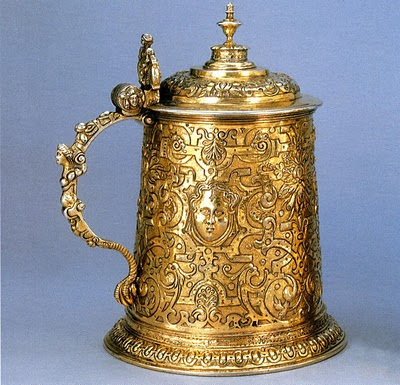First here is this beautiful 16th century Hungarian belt buckle, decorated with pearls and rubies:
 |
| Belt buckle from the Salgó collection Metropolitan Museum, 2010.110.1 |
Then there is a nice late 16th century silver-gilt tankard from Transylvania, made by the goldsmith Gregorius Gunesch (Nagyszeben/Hermannstadt/Sibiu). It is not illustrated in the collection database, the picture below is from the 1996 catalog.
 |
| Silver-gilt tankard from the Salgó collection Metropolitan Museum of Art, 2010.110.6 |
Somewhat later is one of my favorite pieces from the Salgó-collection, a spice canister from 1681, commissioned by Michael Teleki, chancellor of Mihály Apafi, Prince of Transylvania. Once again the image below is from the 1996 catalog - a brief description is given by the Metropolitan Museum collection database.
 |
| Spice canister from the Salgó collection Metropolitan Museum, 2010.110.39 |
There is a lot more in the collection. I will give an update here, once more images will be added to the collection database of the museum.
That late 16th century silver-gilt Transylvania tankard, made by the goldsmith Gregorius Gunesch, is gorgeous. To my eyes, it has the shape and decorative elements of contemporary silver art from Augsburg.
ReplyDeleteYes, that is absolutely correct - goldsmith art in Hungarian and especially in Transylvanian towns was very closely related to contemporary developments in Augsburg and Nuremberg. These towns were largely populated by ethnic Germans (Saxons). A famous example of such contacts: the father of Albrecht Dürer was a goldsmith, who moved to Nuremberg from a village near the Hungarian town of Gyula.
ReplyDeleteÉrdekes volt látni azokat a tárgyakat, amiket lehetőségem adódott restaurálni Salgó Miklós gyűjteményében amikor meghívott 1990-ben. Jó hogy legalább egy helyen maradt a legnagyobb külföldön levő magyar ezüst gyűjtemény, és nem tűnt el a műkereskedelem süllyesztőjében.
ReplyDeleteÖrülök a megjegyzésnek - fel is tettem gyorsan néhány friss részletfotót a középkori kelyhelkről a legújabb bejegyzésben.
ReplyDelete